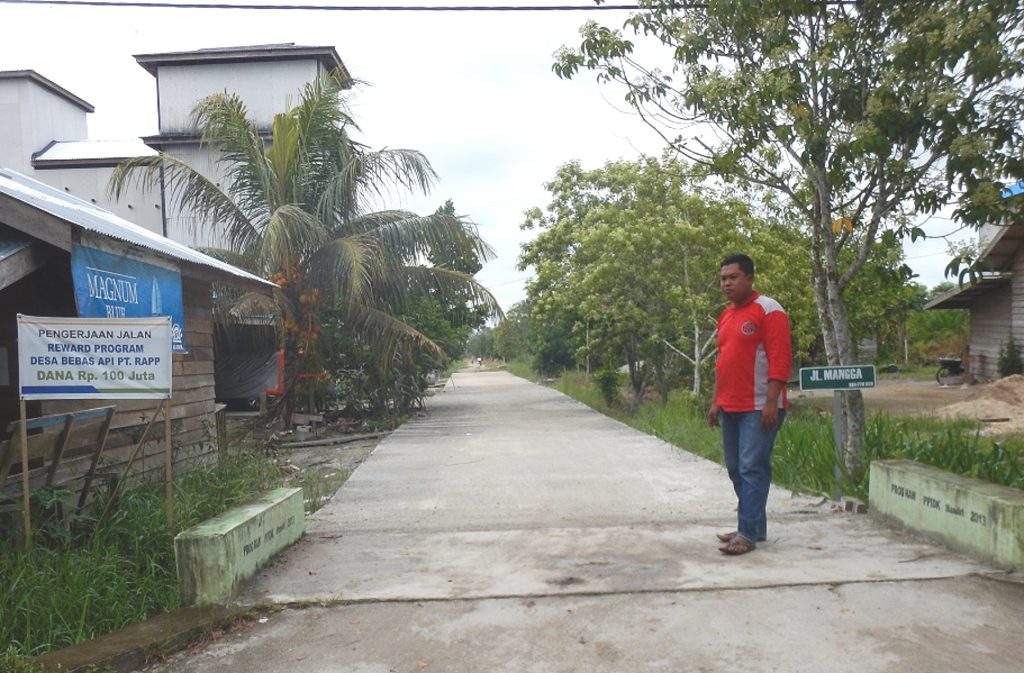Riau Villages Reap the Rewards of a Fire-free Landscape
APRIL’s Fire Free Village Programme (FFVP) is changing lives in Riau province as communities benefit from new infrastructure funded by the programmes’ “No Burn Rewards” initiative. From mosques to marketplaces to sports facilities, villagers are enjoying the benefits of embracing a fire-free landscape.
APRIL’s Fire Prevention Manager, Sailal Arimi, has been instrumental to the success of the FFVP and here he shares insights into why and how the “No Burn Rewards” program has been effective.

Sailal Arimi, Fire Prevention Manager
Q: Why was the No Burn Rewards initiative important to the successful launch of FFVP?
SA: When we launched FFVP, we were trying to change long-established cultural practices and this was hard for some people to accept. It was important for us to explain why burning itself was a problem in so many ways and, understandably I think, we needed an incentive that would deliver an immediate reward. This was also vital for the village leaders and crew leaders in getting the support of their communities.
Q: What constitutes a reward?
SA: Villages receive either a full or partial reward based on their fire free record during the year, and this is judged by an independent panel of officials and NGOs. The rewards are given as infrastructure grants for community projects. The infrastructure projects also are reviewed and agreed by the panel. We don’t issue cash grants, but the value of infrastructure grants awarded was just under US$100,000 across 14 communities in 2016.
Q: What kind of infrastructure have the villages built with their rewards grants?
It has been quite varied according to village needs and priorities. In nine villages, the mosques have been renovated or have had new facilities added. Some villages have built new courts for football, basketball and volleyball. In others the village marketplaces have been improved. There have also been road improvements. So the rewards have contributed to a very wide range of infrastructure that helps the entire community.
Q: What kind of reaction has there been from the people living in these communities?
SA: Overall, talking to people in the villages has shown me how pleased they all are and how they understand the effort and change in attitude was worthwhile for the long-term welfare of their community. Of course, they have also been pleased with their specific rewards based projects. In Kuala Panduk, for example, the new mosque facilities mean the villagers can do their morning purification ritual in the mosque rather than going down to the river for their ablutions. The village crew leader also says that the community is enjoying the improved road to the school and the new stand in the sports center.

New road at Teluk Meranti
In Teluk Meranti, the village head and crew leader said the whole community is very happy with the culvert and road concreting which now means there is no more muddy road during the rainy season.
Q: How would you assess the success of the Rewards program so far?
SA: From the 2016 FFVP, 14 villages out of the 18 that participated earned rewards. I think this shows that the communities understand the importance of fire prevention. This was also true among the communities that, disappointingly, did not achieve a reward. The most important thing however is that people really understand why burning is bad and that there is a cultural shift in thinking.
Of course, it is clear that the possibility of rewards helped a lot to get support for FFVP at the beginning. Looking ahead, I think that seeing and using the rewards infrastructure every day will be a very important reminder to people of the importance of fire prevention.

Fire Alert Community meeting place built with FFVP rewards
Q: Are there any villages which have failed to ever get Rewards?; And if so, why?
SA: Yes, since FFVP started there have been some villages that didn’t achieve a reward during their two years in the program. This was mainly due to a few individuals who held on to the belief that burning was the best way to prepare land. This is disappointing for us and, I think, for those communities as a whole. They are still part of the Fire Resilient Communities program so will continue to get educational and other support to encourage a fire free landscape. I think overall most of the people in those communities have come out of the program understanding the hazards of fire. I believe that long-term they will play their part in preventing fires.
Q: Personally-speaking how do you feel about your involvement in introducing and implementing the No Burn Rewards program?
SA: I am very proud to be involved. I know that fires are a huge hazard to the environment and threaten the lives and health of millions of people, including children in Indonesia and further away. I also have seen the immediate effect on local communities and it is very satisfying to see the people in the villages enjoying their rewards and how they are improving their lives.
Q: Is there a danger that once the “rewards” stop some villages will return to the old practice of burning land?
SA: No I don’t think so. The communities understand the difference that preventing fires has made to their lives and even the health of their children. The rewards definitely encouraged them at first to listen to what we had to tell them but now they truly understand how important it is. Even many of their children learned this through our education program targeting schools. So I think we have started a long-lasting cultural shift towards achieving a fire-free future.
For more information on the FFVP, read Carbon Conservation’s 2016 Review summary.




